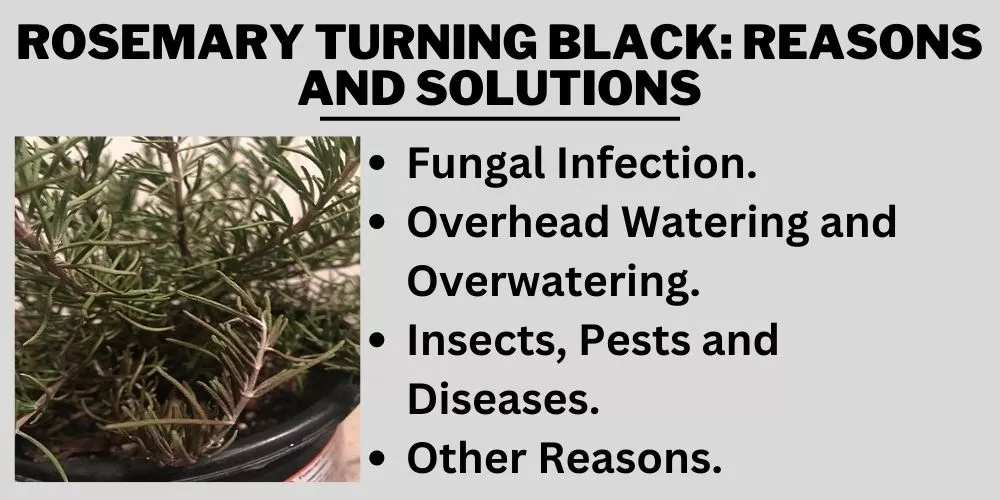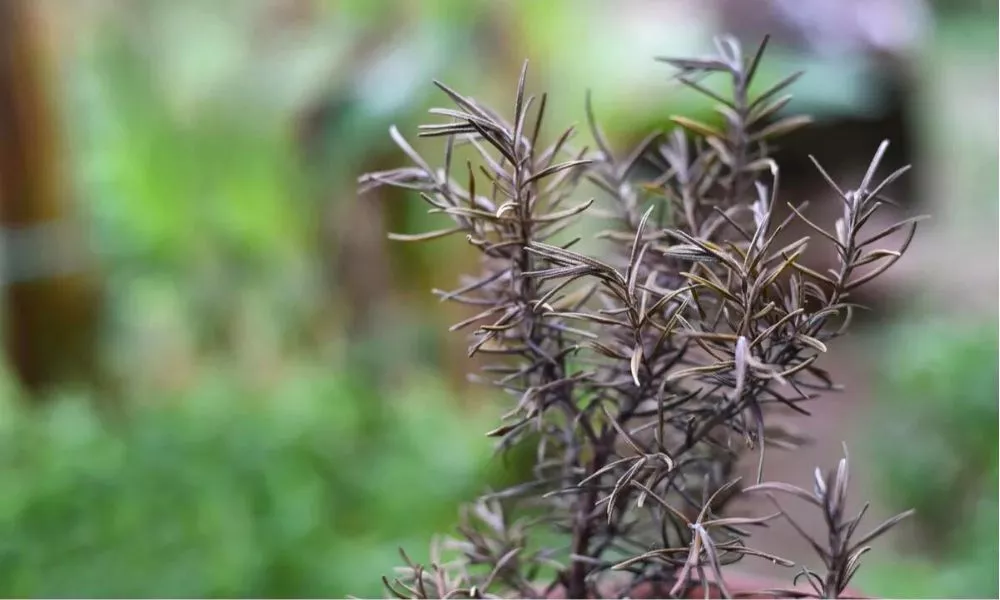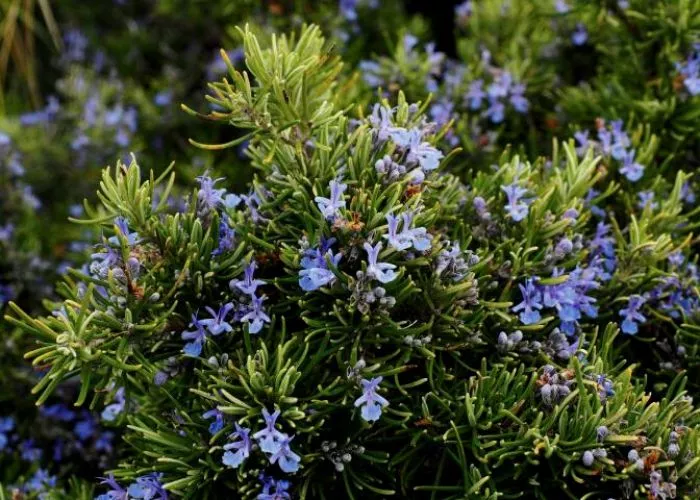Rosemary turning black is a serious issue, and it can cause due to many reasons.
However, the root cause (mind the pun) is growing the herb under high humidity, dampness around the roots by overwatering and poor soil drainage.
As a result, a domino-like effect can occur, bringing more problems. These include root rot, fungal diseases such as Botrytis and/or black spot and, pest infestations.
In this article, we’ll look deeper into the causes and how to treat them.

Table of Contents
Rosemary Turning Black: Reasons and Solutions
Rosemary is a hardy, drought-resistant plant. It doesn’t require a ridiculous amount of water to thrive.
So when it does receive too much water, several other issues can be brought on. Excess watering can be caused by heavy rainfall, manual overwatering and overhead watering.
Additionally, the moisture content can build critical levels when the plant is grown in poorly drained soil.
Furthermore, high humidity can attract various pests and diseases if not mitigated and maintained. Let’s look at all the problems that excess moisture can cause and how to correct them.

Fungal Infection
The most common fungal infections that can turn a rosemary plant black are black spots, cercospora leaf spots, and powdery mildew.
Since the origin of the rosemary plant is in the Mediterranean regions, they are used to full sun and low humidity. Over time, we have taken them under our wings and planted them wherever we please. This includes cramping them in our garden.
When placed or planted too close to each other, airflow is reduced, and humidity increases.
As a result, the plant begins to sweat and these types of disease leach on and grow their little colonies in these perfect environments. Here’s how to identify each disease:
- Black Spot – The leaves start to form yellow spots, which turn brown and then black if not treated.
- Cercospora Leaf Spot – The leaves become discolored. When fully infected, they will first turn yellow, brown, and/or black. You may also notice smaller black spots on the leaves, which almost override the discoloration.
- Powdery Mildew – Powdery mildew starts by forming gray/white powdery patches and spots on its leaves and/or stems. It looks a lot like webby talcum powder. As the fungal spores begin to spread and multiply, they can spread quickly. The gray colors can turn yellow to brown and black in the worst cases.
How do you treat fungus on rosemary?
First, remove the plant from its growing area and prune away any dead or decaying leaves and limbs. This will give your plant every chance of recovery once completely treated.
It will focus its energy on healing living foliage instead of decaying areas.
Burn or dispose of the affected parts to avoid spreading the disease to other healthier plants. Do not just throw them in the compost; the whole compost can become diseased.
The next step is to spray the rosemary with a good quality organic fungicide such as copper diammonia diacetate complex.
Check to see if your plant can tolerate this. It is, however, a good general-purpose fungicide that can treat these diseases. Neem oil and potassium bicarbonate are also quite effective.
Overhead Watering and Overwatering
Watering your plant from above for most plants is a big no no! It’s a recipe for disaster. When watering onto the leaves, water runs through the plant and the stem.
Any remaining moisture can start a whole civilization of disease forming, which in turn causes the rosemary plant to go black.
The best way to water rosemary is by using a soft pouring hose nozzle and gently watering the soil around the stem. If anything splashes up, try to dry it out to prevent later issues.
On the other hand, overwatering can be a problematic means of leaving the roots bathing in a pool of water at the bottom of their planting container. As a result, the rosemary can form root rot.
Root rot begins at the roots and slowly works its way up the plant. If detected too late, it will take over and kill the plant.
The best way to water a rosemary plant is by first checking the soil for moisture content. Once the plant is bone dry, it is safe to water it again. Rosemary is a hardy, almost drought-proof plant, so it’s ok to go short periods without water.
Solution
The solution for overhead watering is simple. Make sure you get down really low and only water the soil around the base of the plant’s stem.
If the diseases start to take over, refer to a little higher up this article to see how to counteract them. Overwatering can be mitigated by first gauging the moisture content of the soil and water accordingly.
If unsure, you can take a chopstick or skewer and poke it down beside the stem and roots. If it comes out bone dry, it’s safe to water.
Rosemary only needs to be watered once a week in the summertime and every 2 weeks during the spring and fall (autumn) periods.
They don’t need anything during the winter as they are dormant. Their chances of root rot will increase if the water is in the winter.
Insects, Pests and Diseases
Certain insects and pests are attracted to the disease and excess moisture left on the rosemary plants. As a result, pests such as spider mites, mealybugs, thrips, whiteflies, and spittlebugs are the main culprits for destroying your rosemary.
Once they colonize the plant, they suck on the leaves and produce black marks. Additionally, they leave small deposits of honeydew which attract more pests such as ants.
Consequently, the whole plant can turn black as they are weakened and left semi-lifeless.
What to look for (Spotting them)
- Spider mites – These little buggers are extremely hard to see. They look almost like tiny moving dots. The webs, however, are slightly more visible. They latch on and suck out all the nutrients and water from the plant.
- Mealybugs – are tiny insects but are easier to spot than spider mites. They are pink/purple but are more seen as white/gray as they cover themselves with a protective waxy cotton substance. These guys damage the rosemary by feeding on the plant’s sap.
- Thrips – Similar to spider mites, they are hard to spot. They are usually light green or yellow. They almost look like really small dark slivers when studied closely. Thrips stipple the leaves and kill the tissue cells causing them to wrinkle and turn black.
- Whiteflies – Whiteflies look like small white moths. They ooze out a sticky substance which sets onto the leaves and causes black spots to appear.
- Spittlebugs – They are orange, yellow or green, depending on their age. They turn the whole plant black by first leaving saliva-like foam on the leaves. The foam dries up and eats the whole plant as it becomes infested with more bugs.
How to get rid of insects and treat rosemary diseases?
Insecticidal soap or rubbing alcohol are great choices. Neem oil should always be your go-to, though, as it is organic and can also be made at home for quite cheap.
It is also extremely effective against soft-bodied insects and bugs like the ones mentioned above. Making your solution is as simple as mixing:
- 1 tbs concentrated, cold-pressed neem oil.
- 1 tsp liquid soap.
- with 1 gallon (3.8 liters) of water.
Add them to a spray bottle and coat the whole plant. Observe it to see how it reacts over the next 48 hours. Reapply if needed.
Other Reasons
Lack Of Sunlight And How To Solve This Problem
If rosemary isn’t getting enough sunlight, it will slowly turn brown and black and shed its leaves. All plants need either direct or indirect sunlight to grow and survive.
It’s an important aspect of the photosynthesis process. Rosemary plants require at least 6 hours of full sunlight per day. They don’t need much shade, either.
Quick Fix – Simply move your plants somewhere that gives your rosemary plant the correct amount of sunlight. If you have them planted in the garden, it’s best to uproot them and move them somewhere more appropriate.
Otherwise, they just won’t grow or produce the leaves that they could potentially be growing.

Slow Draining Soil And How To Solve It
The drainage becomes less efficient when a rosemary plant is planted using soil that is too rich in clay or other extremely binding type materials. If the plant cannot drain away its water properly, it will pool up the growing container and rot the roots out.
As we know, root rot will stop the plant from being able to take in important nutrients such as nitrogen because it is drowning in its moisture. The lack of nitrogen and overwatering produce yellow leaves on the plant. These yellow leaves then turn brown and black if not corrected.
Quick Fix – The only way to deal with slow draining soil is digging up the plant and repotting it. Regardless if it’s growing in a pot or the ground. Remove it, gently clean the root system of any heavy clay or debris and replant with new soil.
This way, you know what you have done, and if it doesn’t seem to work, you can try adjusting the next time until you get it right. Rosemary thrives in loamy, nutrient-rich organic soil blends.
How do you take care of a rosemary plant Properly?
Here’s a basic rundown of the growing and caring for your rosemary plant, so it yields continuously through its growing periods.

- Choose an area that receives at least 6 hours of direct sunlight daily.
- Space out your plants as they tend to bush outwards, which can cause issues with excess humidity. The humidity can invite unwanted diseases. Spacing them 2-3 feet apart is optimal.
- Use nutrient-rich, well-draining soil such as a ⅓ aged compost or manure to ⅔ potting mix blend.
- Try to adjust your soil, so it’s slightly acidic and has a pH somewhere between 6.0 and 7.0
- Once planted, rosemary doesn’t necessarily need fertilization, but you can always use a dry fertilizer or diluted water-soluble solution to give it a good kickstart. The liquid variant can be strong so aim to halve it and mix in some water to dilute it.
- Rosemary is tough, hardy and borderline drought resistant. They only really need water when the roots become dry. Aim to water your plants once a week in summer and every 2 weeks in spring and fall. They don’t need any water in winter as they become dormant, and the water will pool and cause root rot.
- When it comes to harvesting, never remove more than ⅓ of the plant at a time or they won’t grow back from that area. Also, ensure that when you are pruning for use, always prune an inch above the greener areas and stay away from the brown woody parts down low. The plant will stop growing if you cut these brown, twiggy sections.
That’s pretty much rosemary in a nutshell. It’s quite easy to grow and maintain. Once it’s up and about, you will have a perennial herb that can grow for up to 30 years if cared for correctly.
Frequently Asked Questions (fAQs)
What does Overwatered rosemary look like?
The tips of the leaves will start turning yellow and eventually turn brown if left unattended. At this stage, the branches will start to droop or wilt, which causes the leaves to shed. Additionally, the plant’s growth will become stunted and powdery mildew can form in extreme cases of neglect.
Can rosemary recover from overwatering?
It depends on the condition of the root system. You will need to uproot the potted or grounded plant (the latter can be a bit more tricky). If there are still visibly healthy lengths of roots that show signs of life, then you’re in luck.
Prune away any dead or decayed areas, spray some fungicides such as neem oil on the affected areas and report. Make sure you let the air of the root out before planting in new, well-draining, nutrient-rich soil.
Does rosemary like the full sun?
Rosemary loves the sun. They originated in the Mediterranean, where they were kissed by the sun day in and out. So ensure they get a minimum of 6-8 hours of direct sun daily.
Can you save a rosemary plant with root rot?
It depends on how much of the plant the root rot has managed to destroy. The best thing to do is pull up the plant and gently rinse away the soil to reveal the damage. Prune the affected areas and replant them in new, better quality, well-draining soil.
Additionally, trim away any leaves on the top end of the plant that has been discolored. This will encourage the plant to focus its energy on healthy areas and boost them instead of wasting time trying to revive discolored, possible dead foliage.
Why does my rosemary have black spots?
Black spots can form due to some different stress issues. They can include mold formed by certain diseases, a range of pests and/or bugs, and overwatering. Overwatering is generally the main cause as it attracts disease and pests.
Can you eat rosemary with black spots?
The black spots on rosemary aren’t particularly dangerous. Although it’s not a good idea for humans to consume disease and mold, which is essentially what the black spots are.
Conclusion
As we have discovered, rosemary turning black can happen due to various reasons. One of the biggest mistakes you can make is planting your rosemary in poorly draining soil and overwatering them.
Those 2 factors alone can almost single-handedly ruin your rosemary crop with ease.
Making sure you start with a good base will improve their chances of survival. We hope that this article has been helpful, and we look forward to creating more just like it to help answer any more queries such as this one.


